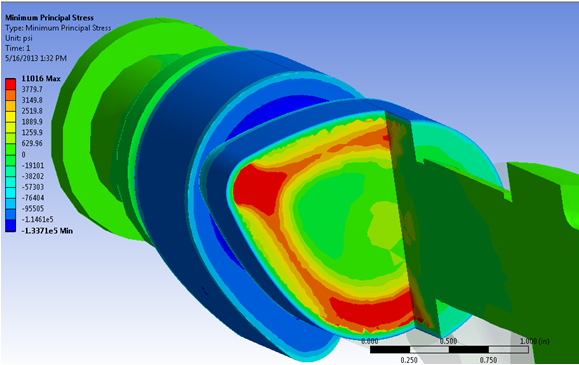Laser Peening Application Review: Crankshafts and Camshafts
Camshafts and crankshafts intended for high performance applications, heavy-duty environments, or those that serve as critical load-bearing components can be significantly improved with laser peening.
Posted: May 28, 2013
By:
Camshafts and crankshafts intended for high performance applications, heavy-duty environments, or those that serve as critical load-bearing components can be significantly improved with laser peening. Incorporating laser peening into new designs opens up many cost-saving possibilities including weight reduction and cheaper material selection. The powerful fatigue enhancement benefits offered by laser peening cannot be replicated with the comparatively shallow compressive residual stresses produced by shot peening.
The Challenge
Improving the fatigue performance of rotating automotive engine components
Materials
- 1045 – 1060 steel
- 15xx steel
- 4140
- Surface hardened journals and lobes (induction hardened, carburized, etc.)
Failure Mechanisms
- Rolling contact fatigue (spalling/flaking)
- Bending/Torsion fatigue
- Surface wear/abrasion
Cost of Failure
When looking at the overall cost of a component failure, there are many important aspects in addition to the part cost itself. Some costs are quantifiable with expected dollar values. Others are more abstract, but can do significant damage to a company or brand. Here are just a few items to consider:
- Cost of replacement part
- Cost of labor to replace part
- Lost time due to maintenance/replacement
- Reputation damage/Unhappy customers
- Damage to future sales
- Property damage/Bodily injury/Loss of life
Crankshafts and camshafts are found in millions of engines for millions of applications, but all operate under the same basic principles.
Crankshafts are responsible for transferring the combustion forces to the flywheel or other engine output device. For a common 4-stroke engine, the combustion process occurs at the top of the cylinder, driving the piston back down the cylinder. The energy is transferred from the piston head to the piston rod, and converted into torque (rotational force) at the crankshaft. The crankshaft can then be used to power many different secondary components. As a result of the force generated by combustion, the crankshaft experiences bending loads on the main and rod journals, which are usually the most severe at the fillet radii between the counter-weights and journals. There are also torsional forces that strain the component when loads are applied to the output end of the crankshaft. The net effect is that crankshafts are prone to cracking and failure.
The camshaft is responsible for opening and closing the valves as combustion takes place. These valves allow the air and fuel mixture to enter the combustion chamber (unless direct-injected) and allow the exhaust gases resulting from combustion to be released from the cylinder. Most camshafts failures result from the cam lobes spalling or wearing down. Camshaft failures are also common in high-performance applications with stiff valve springs, or applications where heavy bending loads are realized on the crankshaft.
The Solution
Laser peening has been shown to improve the bending fatigue life of steel components by 10x, while increasing the fatigue strength by over 30%. This enables longer lasting components that can be engineered with less material for reduced weight. Laser peening delivers improved engine efficiency, reliability and performance. A win for you and your customers.
The compressive residual stresses produced by laser peening will increase resistance to fatigue crack initiation that results from rolling surface contact. The deep compressive residual stress profiles also increase cracking resistance from debris contamination and wear.
The Results
Reduced Weight Designs
Safe stress levels for a part are often a function of the load applied to the part divided over the area which handles the load. The increase in fatigue stress threshold from laser peening allows components to be designed with less material without compromising the strength and safety of the part. Less material means less weight, fewer parasitic losses, and greater efficiency and power as a result.
Less Expensive Materials
Imagine cutting the cost of replacement parts in half without sacrificing quality or performance. Laser peening makes this a reality by enhancing lesser materials to perform on a level of their more expensive counterparts. With a targeted application of laser peening, ordinary cast iron can deliver the performance of high strength steel. This powerful approach to material enhancement can revolutionize part design.

Extend the Life of Current Components
Every part is designed with an expected service life, but many components fail to meet those estimates. Some critical parts are called upon to outperform service expectations, or function beyond what was originally expected. Under these circumstances, laser peening provides a cost-effective means to extend service life estimates, getting more out of high-value parts. This is particularly valuable when the costs associated with maintenance or replacement are high.
The image on the right depicts a finite element analysis of laser peening camshaft lobes and the bearing journal in between the lobes. Compressive residual stresses on the surface are near the yield strength of the material, and extend to approximately 0.050 inch deep into the lobe. These high magnitude, deep residual stresses help to resist spalling of the journal surfaces and increase the camshaft life.CONTACT US FOR A FREE QUOTE
Interested in Seeing More?
Tell us about your application, material, or failure mechanism and we will have one of our experts reach out to you. Our extensive library of research and years of experience gives us a unique advantage to apply a finite element analysis to help diagnose the best application for your situation.

